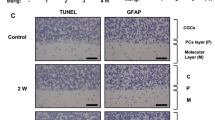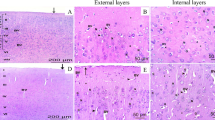Abstract
In this study, we investigated the effect of diphenyl ditelluride (PhTe)2 administration (10 and 50 μmol/kg) on adult mouse behavioral performance as well as several parameters of oxidative stress in the brain and liver. Adult mice were injected with (PhTe)2 or canola oil subcutaneously (s.c.) daily for 7 days. Results demonstrated that (PhTe)2 induced prominent signs of toxicity (body weight loss), behavioral alterations and increased in lipid peroxidation in brain. 50 μmol/kg (PhTe)2 inhibited blood δ-aminolevulinic acid dehydratase (δ-ALA-D), a redox sensitive enzyme. (PhTe)2 caused an increase in cerebral non-protein thiol (NPSH) and protein thiol (PSH) groups. In the liver, 50 μmol/kg (PhTe)2 decreased NPSH, but did not alter the content of protein thiol groups. (PhTe)2 decreased cerebral antioxidant enzymes (catalase (CAT), superoxide dismutase (SOD), glutathione reductase (GR), glutathione peroxidase (GPx), and thioredoxin reductase (TrxR). In liver, (PhTe)2 increase SOD and GR and decreased GPx activity. Results obtained herein suggest that the brain was more susceptible to oxidative stress induced by (PhTe)2 than the liver. Furthermore, we have demonstrated for the first time that TrxR is an in vivo target for (PhTe)2. Combined, these results highlight a novel molecular mechanism involved in the toxicity of (PhTe)2. In particular the inhibition of important selenoenzymes (TrxR and GPx) seems to be involved in the neurotoxicity associated with (PhTe)2 exposure in adult mice.








Similar content being viewed by others
References
Petragnani N (1994) Preparation of the principal classes of organic tellurium compounds. In: Katritzky AR, Meth-Cohn O, Rees CW (eds) Tellurium in organic synthesis. Academic Press, London
Dabdoub MJ, Dabdoub VB, Comasseto JV (1992) Synthesis of (E)-1,4 bis(organyl) but-1-en-3-ynes by lithium-tellurium exchange reaction on (Z)-1-butyltelluro-1,4-bis(organyl) but-1-en-3-ynes. Tetrahedron Let 33:2261–2264
Maciel EN, Bolzan RC, Braga AL, Rocha JBT (2000) Diphenyl diselenide and diphenyl ditelluride affect delta-aminolevulinate dehydratase from liver, kidney and brain of mice. J Biochem Mol Toxicol 14:310–319
de Avila DS, Beque MC, Folmer V, Braga AL, Zeni G, Nogueira CW, Soares FA, Rocha JBT (2006) Diethyl 2-phenyl-2 tellurophenyl vinylphosphonate: an organotellurium compound with low toxicity. Toxicology 224:100–107
Sailer BL, Liles N, Dickerson S, Chasteen TG (2003) Cytometric determination of novel organotellurium compound toxicity in a promyelocytic (HL-60) cell line. Arch Toxicol 77:30–36
Sailer BL, Liles N, Dickerson S, Sumners S, Chasteen TG (2004) Organotellurium compound toxicity in a promyelocytic cell line compared to non-tellurium- containing organic analog. Toxicol In Vitro 18:475–482
Iwase K, Tatsuishi T, Nishimura Y, Yamaguch J, Oyama Y, Miyoshi N, Wada M (2004) Cytometric analysis of adverse action of diphenyl ditelluride on rat thymocytes: cell shrinkage as a cytotoxic parameter. Environ Toxicol 19:614–619
Rooseboom M, Vermeulen NPE, Durgut F, Commandeur JNM (2002) Comparative study on the bioactivation mechanisms and cytotoxicity of Te-Phenyl-L-tellurocysteine, Se-Phenyl-l-selenocysteine and S-Phenyl-l-cysteine. Chem Res Toxicol 15:1610–1618
Roy S, Hardej D (2011) Tellurium tetrachloride and diphenyl ditelluride cause cytotoxicity in rat hippocampal astrocytes. Food Chem Toxicol 49:2564–2574
Heimfarth L, Loureiro SO, Reis KP, De Lima BO, Zamboni F, Lacerda S, Soska ÂK, Wild L, Da Rocha JBT, Pessoa-Pureur R (2012) Diphenyl ditelluride induces hypophosphorylation of intermediate filaments through modulation of DARPP-32-dependent pathways in cerebral cortex of young rats. Arch Toxicol 86:217–230
Heimfarth L, Loureiro SO, Reis KP, De Lima BO, Zamboni F, Gandolfi T, Narvaes R, Da Rocha JBT, Pessoa-Pureur R (2011) Cross-talk among intracellular signaling pathways mediates the diphenyl ditelluride actions on the hippocampal cytoskeleton of young rats. Chem Res Toxicol 24:1754–1764
Moretto MB, Funchal C, Zeni G, Pessoa-Pureur R, Rocha JBT (2005) Selenium compounds prevent the effects of methylmercury on the in vitro phosphorylation of cytoskeletal proteins in cerebral cortex of young rats. Toxicol Sci 85:639–646
Moretto MB, Boff B, Franco J, Posser T, Roessler TM, Souza DO, Nogueira CW, Wofchuk S, Rocha JBT (2007) [45]Ca2+ influx in rat brain: effect of diorganylchalcogenides compounds. Toxicol Sci 99:566–571
Barbosa NBV, Rocha JBT, Zeni G, Emanuelli T, Beque MC, Braga AL (1998) Effect of organic forms of selenium on delta-aminolevulinate dehydratase from liver, kidney and brain of adult rats. Toxicol Appl Pharmacol 149:243–253
Lugokenski TH, Müller LG, Taube PS, Rocha JBT, Pereira ME (2011) Inhibitory effect of ebselen on lactate dehydrogenase activity from mammals: a comparative study with diphenyl diselenide and diphenyl ditelluride. Drug Chem Toxicol 34:66–76
Laden BP, Porter TD (2001) Inhibition oh human squalene monooxygenase by tellurium compounds: evidence of interaction with vicinal sulfhydryls. J Lipid Res 42:235–240
Goncalves TL, Benvegnu DM, Bonfanti G, Frediani AV, Rocha JBT (2009) Delta-ALA-D activity is a reliable marker for oxidative stress in bone marrow transplant patients. BMC Cancer 9:138–143
Prauchner CA, Prestes AS, Rocha JBT (2011) Effects of diphenyl diselenide on oxidative stress induced by sepsis in rats. Pathol Res Pract 207:554–558
Rocha JBT, Saraiva RA, Garcia SC, Gravina FC, Nogueira CW (2009) Aminolevulinate dehydratase (δ-ALA-D) as a marker protein of intoxication with metals and other pro-oxidant situations. Toxicol Res 1(2):85–102
Nogueira CW, Zeni G, Rocha JBT (2004) Organoselenium and organo-tellurium compounds: toxicology and pharmacology. Chem Rev 104:6255–6285
Engman L, Kanda T, Gallegos A, Williams R, Powis G (2000) Water-soluble organotellurium compounds inhibit thioredoxin reductase and the growth of human cancer cells. Anticancer Drug Des 15:323–330
Engman L, Al-Maharik N, Mcnaughton M, Birmingham A, Powis G (2003) Thioredoxin reductase and cancer cell growth inhibition by organotellurium antioxidants. Anticancer Drugs 14:153–161
Sandoval JM, Arenas FA, Vásquez CC (2011) Glucose-6-phosphate dehydrogenase protects Escherichia coli from tellurite-mediated oxidative stress. PLoS ONE 6:e25573
Chen F, Vallyathan V, Castranova V, Shi X (2001) Cell apoptosis induced carcinogenic metals. Mol Cell Biochem 221:183–188
Sandoval JM, Leveque P, Gallez B, Vasquez CC, Calderon PB (2010) Tellurite-induced oxidative stress leads to cell death of murine hepatocarcinoma cells. Biometals 23:623–632
Rozell B, Hansson HA, Luthman M, Holmgren A (1985) Immunohistochemical localization of thioredoxin and thioredoxin reductase in adult rats. Eur J Cell Biol 38:79–86
Arnér ESJ, Holmgren A (2000) Physiological functions of thioredoxin and thioredoxin reductase. Eur J Biochem 267:6102–6109
Lillig CH, Holmgren A (2007) Thioredoxin and related molecules: from biology health and disease. Antioxid Redox Sig 9:25–47
Li D, Wub K, Howie AF, Beckett GF, Wang W, Bao Y (2008) Synergy between broccoli sprout extract and selenium in the upregulation of thioredoxin reductase in human hepatocytes. Food Chem 110:193–198
Du Y, Wu Y, Cao X, Cui W, Zhang H, Tian W, Ji M, Holmgren A, Zhong L (2009) Inhibition of mammalian thioredoxin reductase by black tea and its constituents: implications for anticancer actions. Biochimie 91:434–444
Matsui M, Oshima M, Oshima H, Takaku K, Maruyama T, Yodoi J, Taketo MM (1996) Early embryonic lethality caused by targeted disruption of the mouse thioredoxin gene. Dev Biol 178:179–185
Chaudière J, Ferrari-Iliou R (1999) Intracellular antioxidants: from chemical to biochemical mechanisms. Food Chem Toxicol 37:949–96233
Ursini F, Maiorino M, Gregolin C (1985) The selenoenzyme phospholipid hydroperoxide glutathione peroxidase. Biochim Biophys Acta Gen Subj 839:62–70
De Haan JB, Bladier C, Griffiths P, Kelner M, O’Shea RD, Cheung NS, Bronson RT, Silvestro MJ, Wild S, Zheng SS, Beart PM, Hertzog PJ, Kola I (1998) Mice with a homozygous null mutation for the most abundant glutathione peroxidase, Gpx1, show increased susceptibility to the oxidative stress-inducing agents paraquat and hydrogen peroxide. J Biol Chem 273:22528–22536
Arteel GE, Sies H (2001) The biochemistry of selenium and the glutathione system. Environ Toxicol Pharmacol 10:153–158
Farina M, Campos F, Vendrell I, Berenguer J, Barzi M, Pons S, Suñol C (2009) Probucol increases glutathione peroxidase-1 activity and displays long-lasting protection against methylmercury toxicity in cerebellar granule cells. Toxicol Sci 112:416–426
Farina M, Cereser V, Portela LV, Mendez A, Porciuncula LO, Fornaguera J, Goncalves CA, Wofchuk ST, Rocha JBT, Souza DO (2005) Methylmercury increases S100B content in rat cerebrospinal fluid. Environ Toxicol Pharmacol 19:249–253
Duhan NW, Miya TS (1957) A note on a simple apparatus for detecting neurological deficit in rats and mice. J Am Pharm Assoc 46:208–209
Calberg I, Mannervik B (1985) Glutathione reductase. Methods Enzymol 113:484–490
Wendel A (1981) Glutathione peroxidase. Methods Enzymol 77:325–333
Aebi H (1984) Catalase in vitro. Methods Enzymol 105:121–126
Misra HP, Fridovich I (1972) The role of superoxide anion in the autoxidation of epinephrine and a simple assay for superoxide dismutase. J Biol Chem 247:3170–3175
Berlin A, Schaller KH (1974) European Standardized Method for the determination of d-aminolevulinic acid dehydratase activity in blood. Zeitschrift Fur Klin Chem Klin Biochemie 12:389–390
Arner ESJ, Zhong L, Holmgren A (1999) Preparation and assay of mammalian thioredoxin and thioredoxin reductase. Methods Enzymol 300:226–239
Ellman GL (1959) Tissue sulfhydryl groups. Arch Biochem Biophys 82:70–77
Franco JL, Rivella DB, Trevisan R, Dinslaken DF, Marques MR, Bainy AC, Dafre AL (2006) Antioxidant status and stress proteins in the gills of the brown mussel Perna perna exposed to zinc. Chem Biol Int 160:232–240
Ohkawa H, Ohishi N, Yagi K (1979) Assay for lipid peroxides in animal issues by thiobarbituric acid reaction. Anal Biochem 95:351–358
Lebel CP, Ischiropoulos H, Bondy SC (1992) Evaluation of the probe 2,7-dichlorofluorescein as an indicator of reactive oxygen species formation and oxidative stress. Chem Res Toxicol 5:227–231
Garcia-Ruiz C, Colell A, Mari M, Morales A, Fernandez-Checa JC (1997) Direct effect of ceramide on the mitochondrial electron transport chain leads to generation of reactive oxygen species – role of mitochondrial glutathione. J Biol Chem 272:11369–11377
Bradford MM (1976) A rapid and sensitive method for the quantitation of microgram quantities of protein utilizing the principle of protein–dye binding. Anal Biochem 72:248–254
Rawlins FA, Smith ME (1971) Myelin synthesis in vitro: a comparative study of central and peripheral nervous tissue. J Neurochem 18:1861–1870
Said G, Duckett S, Sauron B (1981) Proliferation of Schwann cells in tellurium-induced demyelination in young rats - a radioautographic and teased nerve fiber study. Acta Neuropathol 53:173–179
Holmgren A (1985) Thioredoxin Ann Rev. Biochem 54:237–271
Garberg P, Engman L, Tolmachev V, Lundqvist H, Gerdes RG, Cotgreave IA (1999) Binding of tellurium to hepatocellular selenoproteins during incubation with inorganic tellurite: consequences for the activity of selenium-dependent glutathione peroxidase. Int J Biochem Cell Biol 31:291–301
Farina M, Aschner M, Rocha JBT (2011) Oxidative stress in MeHg-induced neurotoxicity. Toxicol Appl Pharmacol 256:405–417
Stangherlin EC, Rocha JBT, Nogueira CW (2009) Diphenyl ditelluride impairs short term memory and alters neurochemical parameters in young rats. Pharmacol Biochem Behav 91:430–435
Jung KA, Kwak MK (2010) The Nrf2 system as a potential target for the development of indirect antioxidants. Molecules 15:7266–7291
Ni M, Li X, Yin Z, Jiang H, Sidoryk-Wegrzynowicz M, Milatovic D, Cai J, Aschner M (2010) Methylmercury induces acute oxidative stress, altering Nrf2 protein level in primary microglial cells. Toxicol Sci 116:590–603
Kann O, Kovacs R (2007) Mitochondria and neuronal activity. Am J Physiol Cell Physiol 292:641–657
Floyd RA (1999) Antioxidants, oxidative stress, and degenerative neurological disorders. Proc Soc Exp Biol Med 222:236–245
Behl C, Moosmann B (2002) Oxidative nerve cell death in Alzheimer’s disease and stroke: antioxidants as neuroprotective compounds. J Biol Chem 383:521–536
Berg D, Youdim MB (2006) Role of iron in neurodegenerative disorders. Topics Mag Reson Imag 17:5–17
Acknowledgments
This study was supported by grants from CAPES, FINEP-IBNet, FAPERGS-PRONEX, INCT-CNPq for Excitotoxicity and Neuroprotection and CNPq.
Author information
Authors and Affiliations
Corresponding authors
Rights and permissions
About this article
Cite this article
Comparsi, B., Meinerz, D.F., Franco, J.L. et al. Diphenyl ditelluride targets brain selenoproteins in vivo: inhibition of cerebral thioredoxin reductase and glutathione peroxidase in mice after acute exposure. Mol Cell Biochem 370, 173–182 (2012). https://doi.org/10.1007/s11010-012-1408-6
Received:
Accepted:
Published:
Issue Date:
DOI: https://doi.org/10.1007/s11010-012-1408-6




